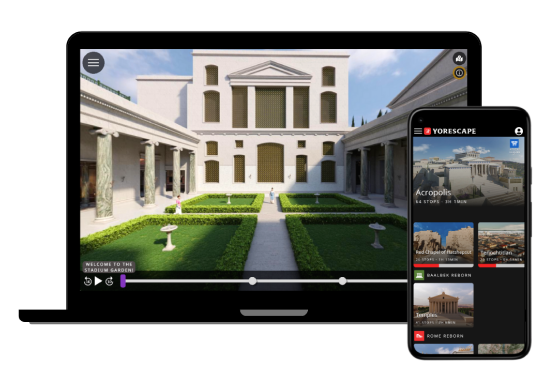
Tenochtitlan was the capital of the Mexica (or Aztec) Empire located in the Basin of Mexico, a now-vanished lake occupied by Mexico City. This city of perhaps 300,000 inhabitants–one of the largest in the world at the time–consisted of a dense network of islands and artificial platforms interconnected by canals and linked to the mainland by causeways.
Read More

- Description
- Languages
- Credits
- Bibliography
The capital of the Mexica (or Aztec) Empire is brought back to life as it appeared in the year 1521 CE, on the eve of the Spanish invasion which resulted in its destruction. Stunning aerial views allow you to take in the full extent of this sprawling city built on islands and reclaimed land in Lake Texcoco, now the site of Mexico City. A team of professional Mesoamerican archaeologists explain its history and significance and take you to its most important structures. Along the way you will learn about the most prominent features of Mexica society and culture, including administration, water management, agriculture, art and architecture, commerce, education, religion, and warfare.
Audio: English, Spanish
Subtitles: English, Italian, Spanish
Project Managers:
David R. Hixson
Jeffrey R. Vadala
Producer:
Bernard Frischer
Tour Guide/Narration:
Atta Otigba (English)
Carlos Ortíz Ozeta (Spanish)
Script:
Nezahualcoyotl Xiutecutli
David R. Hixson
Carlos Ortíz Ozeta
Randee Fladeboe
Nancy Peniche May (Spanish)
3D Modeling:
Jeffrey R. Vadala
Art Direction:
Mohamed Abdelaziz
Contributors:
Santiago Ferreyra / ADV Estudio
Susan Gillespie
Gerardo Gutierrez
Captions:
Ambra Spinelli (Italian)
Nancy Peniche May (Spanish)
Image Credits:
Images by Deror_avi, Adriel A. Macedo Arroyo, Drini, Chaccard, Satori Marort, Luidger, and Joe Ravi via Wikimedia Commons (CC BY-SA 3.0 and CC BY-SA 4.0)
Created By:
Flyover Zone
- M. Aguilar-Moreno, “Ulama: Pasado, Presente, y Futuro del Juego de Pelota Mesoamericano.” Anales de Antropología 49.1 (2015): 73-112.
- L. Alicino, “El concepto de xochiyaoyotl en el mundo prehispánico según las Relaciones de Chimalpahin Cuauhtlehuanitzin.” Ancient Mesoamerica 30 (2019): 235-244.
- R. Atwood, “Under Mexico City.” Archaeology 67.4 (2014): 26-33.
- J. E. Becerril and B. Jiménez, “Potable Water and Sanitation in Tenochtitlan: Aztec Culture.” Water Supply 7.1 (2007): 147-154.
- C. S. Beekman and A. F. Christensen, “Controlling for Doubt and Uncertainty Through Multiple Lines of Evidence: A New Look at the Mesoamerican Nahua Migrations.” Journal of Archaeological Method and Theory 10.2 (2003): 111-164.
- E. Boquedano, Tezcatlipoca: Trickster and Supreme Deity. Boulder: University Press of Colorado, 2015.
- E. Brumfiel, “Huitzilopochtli’s Conquest: Aztec Ideology in the Archaeological Record.” Cambridge Archaeological Journal 8.1 (2008): 3-13.
- E. E. Calnek, “Settlement Pattern and Chinampa Agriculture at Tenochtitlan.” American Antiquity 37.1 (1972): 104-115.
- V. Candiani, “The Desagüe Reconsidered: Environmental Dimensions of Class Conflict in Colonial Mexico.” Hispanic American Historical Review 92.1 (2012): 5-39.
- D. Carrasco, “Human Sacrifice: Aztec Rites, in L. Jones (ed.), Encyclopedia of Religion Vol. 6 (2nd ed.; Detroit: Macmillan Reference USA, 2005), 4185-4191.
- D. Carrasco, Quetzalcoatl and the Irony of Empire: Myths and Prophesies in the Aztec Tradition. Revised ed. Boulder: University Press of Colorado, 2000.
- I. Clendinnen, Aztecs: An Interpretation. New York: Cambridge University Press, 2000.
- C. E. Cordova, “Pre-Hispanic and Colonial Flood Plain Destabilization in the Texcoco Region and Lower Teotihuacan Valley, Mexico.” Geoarchaeology: An International Journal 32 (2017): 64-89.
- A. Couvreur, “Beyond Rain and Storm: Tlaloc and His Relationship with Warfare, Earth and Territory in Teotihuacan.” Americae 2 (2017): 99-112.
- L. Cué, “Coyolxauhqui. La Muerte de la Diosa.” Artes de México 96 (2009): 36-41.
- N. Davis, The Aztecs. Norman: University of Oklahoma Press, 1973.
- T. de Benavente (“Motolinia”), Historia de los Indios de la Nueva España. Madrid: Real Academia Española, Centro para la Edición de los Clásicos Españoles, 2014.
- B. Díaz del Castillo with E. de Vedia (ed.), Verdadera Historia de los Sucesos de la Conquista de la Nueva España (Biblioteca de Autores Españoles desde la Formación del Lenguaje hasta Nuestros Días. Historiadores Primitivos de Indias, 2 vols.) Madrid: Rivadeneyra, 1862 (1555).
- D. Durán with J. F. Ramírez (ed.), Historia de las Indias de Nueva España y Islas de Tierra Firme, 2 vols. Mexico: Imprenta de J. M. Andrade y F. Escalante, 1867-1880.
- G. Gutiérrez, “Mexico-Tenochtitlan: Origin and Transformations of the Last Mesoamerican Imperial City,” in Norman Yoffee (ed.), The Cambridge World History Vol. 3: Early Cities in Comparative Perspective, 4000 BCE-1200 CE (Cambridge: Cambridge University Press, 2015), 491-512.
- N. Gutiérrez Solana, “Relieve del Templo Mayor con Tláloc Tlateuchtli y Tláloc.” Anales del Instituto de Investigaciones Estéticas 16.61 (1990): 15-27.
- G. Hernández Sánchez, “Vessels for Ceremony: The Pictography of Codex-Style Mixteca-Puebla Vessels from Central and South Mexico.” Latin American Antiquity 21.3 (2010): 252-273.
- S. D. Iverson, “The Enduring Toltecs: History and Truth During the Aztec-to-Colonial Transition at Tula, Hidalgo.” Journal of Archaeological Method and Theory 24 (2017): 90-116.
- A. Jimenez Greco and C. Elson, “Archaeology of the Huasteca: The Ekholm Collection.” American Museum of Natural History website (www.amnh.org).
- J. Lockhart, The Nahuas after the Conquest. A Social and Cultural History of the Indians of Central Mexico Sixteenth Through Eighteenth Centuries. Stanford: Stanford University Press, 1992.
- A. López Austin, L. López Luján, and S. Sugiyama, “The Temple of Quetzalcoatl at Teotihuacan: Its Possible Ideological Significance.” Ancient Mesoamerica 2.1 (1991): 93-105.
- G. Lucet, “Dimensioning at the Epiclassic Site of Cacaxtla, Tlaxcala, Mexico: An Expression of Pan-Mesoamerican Complex Thinking.” Latin American Antiquity 26.2 (2015): 242-259.
- J. Maffie, Aztec Philosophy: Understanding a World in Motion. Boulder: University Press of Colorado, 2014.
- R. Martinez-Abarca et al., “Sedimentary Stratigraphy of Lake Chalco (Central Mexico) During Its Formative Stages.” International Journal of Earth Sciences 110 (2021): 2519-2539.
- E. Matos Moctezuma, The Great Temple of the Aztecs: Treasures of Tenochtitlan. New York: Thames and Hudson, 1988.
- A. Monzón Estrada, El calpulli en la organización social de los tenochca. Mexico City: Instituto Nacional Indigenista, 1949.
- B. Mundy, The Death of Aztec Tenochtitlan. Austin: University of Texas Press, 2015.
- J. M. Olson and M. E. Smith, “Material Expression of Wealth and Social Class at Aztec-Period Sites in Morelos, Mexico.” Ancient Mesoamerica 27 (2016): 133-147.
- M. Pastrana Flores, Entre los hombres y los dioses: acercamiento al sacerdocio de Calpulli entre los antiguos nahuas. Mexico City: Universidad Nacional Autónoma de México, 2008.
- T. Reagan, “Developing Face and Heart in the Time of the Fifth Sun: An Examination of Aztec Education.” Paper presented at the 1994 Annual Meeting of the American Educational Research Association, New Orleans, LA, April 4-8, 1994. https://files.eric.ed.gov/fulltext/ED368537.pdf
- P. Romero Lankao, “Water in Mexico City: What Will Climate Change Bring to Its History of Water-Related Hazards and Vulnerabilities?” Environment and Urbanization 22.1 (2010): 157-178. DOI: 10.1177/0956247809362636
- M. E. Smith, “The Aztlan Migrations of the Nahuatl Chronicles: Myth or History?” Ethnohistory 31.3 (1984): 153-186.
- B. L. Stark and W. D. Stoner, “Watching the Game: Viewership of Architectural Mesoamerican Ball Courts.” Latin American Antiquity 28.3 (2017): 409-430.
- K. A. Taube, “Creation and Cosmology: Gods and Mythic Origins in Ancient Mesoamerica,” in D. L. Nichols (ed.), The Oxford Handbook of Mesoamerican Archaeology (New York: Oxford University Press, 2012), 742-751.
- G. A. Torres Alves and O. Morales Nápoles, “Reliability Analysis of Flood Defenses: The Case Study of the Nezahualcoyotl Dike in the Aztec City of Tenochtitlan.” Reliability Engineering and System Safety 203 (2020): 107057.

Subscribe to our Newsletter
Receive updates and exclusive promotions from Flyover Zone





